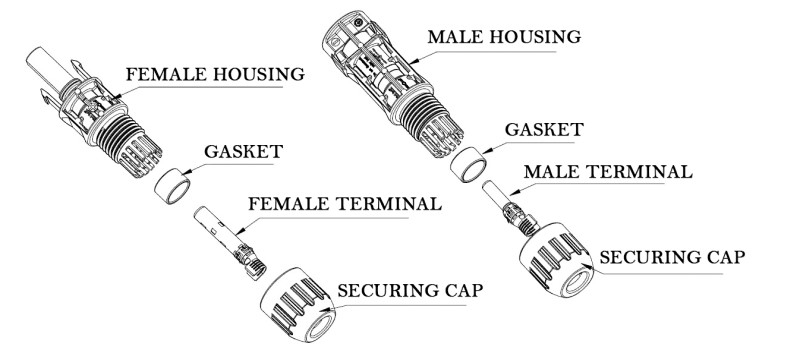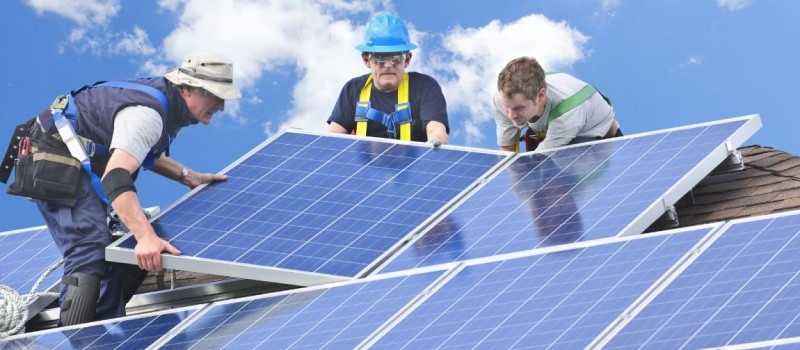A solar connector, also known as a photovoltaic connector, is a device used to create a safe and reliable electrical connection between solar panels. Solar connectors also connect solar panels to other components of a solar power system such as inverters, solar charge controllers and batteries. Solar connectors ensure efficient energy transfer and minimize any power loss in the system to facilitate your off-grid living.
Structure of Solar Connectors
First of all, we need to know that a complete solar module connector consists of a male connector and a female connector, which need to be inserted into the female connector in order for the connector to function. They have a special and inter-matched structure inside to ensure that they can be successfully locked after insertion and that the contact is tight. With this basic knowledge, we can begin to understand the components of a solar connector:

- Male or female housing: Both male and female connectors need a shell, that is housing, which determines the appearance and size of the connector. It is usually made of high temperature resistant, weather resistant engineering plastics with good insulating properties and UV resistance. As shown in the figure, the structure of male housing and female housing is different.
- Male or female terminal: Also known as contact pin, it is usually made of high-quality copper alloy to ensure electrical conductivity and corrosion resistance. Similarly, male and female terminals have different profiles, as evidenced by the fact that female terminals have an empty interior.
- Gasket: As a cushioning and connecting material, it keeps the terminal embedded in the housing in place and acts as a bridge between the two. It usually has excellent waterproof performance.
- Securing cap: It can also be called as screw or nut which is used for connecting cables and connectors and also for protection. It is made of resin material with good heat and cold resistance to avoid causing disasters such as fire.
As part of a photovoltaic system, PV connectors need to match its convenience, speed, and ability to be used in any location, so there are high demands on the materials used for the components. Common portable solar generators are likely to be used in areas with hot, humid, warm, cold, dry and other climate types, and the solar connector must be able to adapt to most of these environments.
Working Principle of Solar Connectors
A solar connector is a special connector used to connect photovoltaic modules to other electrical devices. Its main principle is to convert solar rays into direct current (DC) electrical energy and transmit it to an inverter or the grid for storage or use. The male and female connectors are electrically conductive. After an electrical connection is established between the male and female terminals, the transmission of current and signals can be realized.
When using a PV connector, the photovoltaic module converts solar rays into DC electrical energy and delivers it into the male connector. The laminated piece in the male connector will ensure that the current flows properly into the female connector and makes connections to other electrical devices. With a PV module connector, DC electrical energy can be converted through an inverter and sent out into the grid for home or commercial use.
Although there are several types, the most common solar connector with the majority of the market share is the MC4 solar connector. MC4 stands for "Multi-Contact, 4mm" and refers to the 4mm diameter of the connector's contact pins. MC4 connector is designed to be weatherproof, UV-resistant, and resistant to harsh environments in order to provide a secure, long-lasting connection.
Function and Application of Solar Connectors
Although the photovoltaic connector accounts for a small percentage of the cost of the overall photovoltaic system, there are many applications, including junction boxes, convergence boxes, modules and inverters in which it is used.

- Solar connectors are critical to solar power systems to ensure electrical efficiency, safety, weather resistance, scalability, ease of installation and maintenance, and compatibility between components.
- Solar connectors minimize power loss and maintain overall system efficiency by providing a safe and reliable connection between solar panels and other components in the balance of the system.
- Solar connectors also protect against potential hazards such as arcing or short circuits and help withstand environmental conditions such as UV radiation, temperature extremes and moisture. High-quality PV connectors should last the lifetime of the solar power system (approximately 25 to 30 years).
- Solar connectors help easily expand solar panels arrays in series or parallel configurations for flexible system design. They simplify installation, maintenance and compatibility of different solar panel brands and components.
The solar connector has the advantages of high reliability, easy to use, good waterproof and dustproof performance. Its structure is reasonably designed to ensure the stability and reliability of the electrical connection. Solar module connectors are widely used in solar power generation systems, is an indispensable and important part of it. Through the use of high-quality solar connectors, can improve the efficiency and safety of solar generator. In the future, solar connectors will still be developed to improve electrical efficiency, safety, weather resistance, scalability, and ease of installation and maintenance.
(1).png)
(1).png)